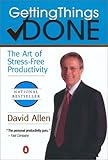What’s stopping you from achieving your dreams? For many people it’s simple, they haven’t verbalized their dreams. Without verbalization, dreams can’t happen. Others will fire back the usual dream, “I want to be rich and happy”. Having a dream is a step in the right direction but if you haven’t turned your dreams into actionable items and pursued it, that’s what it will remain- a dream but not reality. So how can you turn a dream into reality? There are 4 easy steps: verbalize the dream, set your goals, create a plan to turn that dream into reality and of course execute. In this part we will focus on verbalizing the dream.
Determining Your Dreams
One of the key points of the Success Making Machine (and how it enhances GTD) is that you are encouraged, dare I say required, to verbalize your dreams. In the dream phase you are picturing what success looks like. At this point, you can make them as unrealistic as you want or as generic as you want, even “I want to be rich and happy”. The more specific you are the more it will help you in the long run. One way to put some structure around your dreams is to verbalize dreams for each area of your life: career, financial, family, social, community, health etc .
Be Positive
When you are verbalizing your dreams- focus on what you want, not what you don’t want. For example, “I want to be rich” is more powerful than “I don’t want to be poor”.
Before you commit to a dream ask yourself if it’s really what you want. Picture your life with your dream achieved. You may find that it isn’t quite what you want. Growing up, many of us wanted to be sports/music or film stars. If you had the magic powers to have the talent for it would you still want it? Maybe you wanted the fun that went with being a baseball player but do you really want to play every single day for 10-20 years? Perhaps you may want it but do you want to keep up that rigorous travel schedule? How will this correspond with your goal of raising a family? So before you commit- think it through.
Buy into your dream
A dream should be something you truly want. Then set your energies to it. Your thoughts, beliefs and actions should be geared toward achieving this goal. You’ll need to believe this dream is possible. You don’t need to know all the details of how it will happen- just know that it will. As you continue to read through this series some of the next steps to success will crystallize. Some would call this the “Law of Attraction” (if you believe/act a certain way you will attract it). This site isn’t build on going into psychological tricks and unproven theories- it’s about logic and actions. Logic tells you if you believe something, invest yourself in it and your mind works toward achieving it, you will be more likely to succeed. You can call it karma- I’ll call it logic.
The Finale
Peter at I will change your life(which I recommend) has a well defined dream:
…to write a book that would help young people, or anyone really, find happiness and meaning in their life…
In the final part in this series I will outline how to use the lessons from this series to approach his dream.
What’s your dream?
Verbalize it and you’ll get closer to achieving it. Now that you’ve started to crystallize your dreams, in the next section we’ll talk about taking steps to achieve it. Subscribe to this feed to be notified when the next part of this series is posted.
 The internet is loaded with content on how you can be more productive and get more done. David Allen’s Getting Things Done: The Art of Stress-Free Productivity has become a virtual bible on how to achieving more in this crazy world. But if you try these techniques with your kids you’ll only end up pulling your hair out. There’s no such thing as being efficient or “processing” inboxes with kids.
The internet is loaded with content on how you can be more productive and get more done. David Allen’s Getting Things Done: The Art of Stress-Free Productivity has become a virtual bible on how to achieving more in this crazy world. But if you try these techniques with your kids you’ll only end up pulling your hair out. There’s no such thing as being efficient or “processing” inboxes with kids.